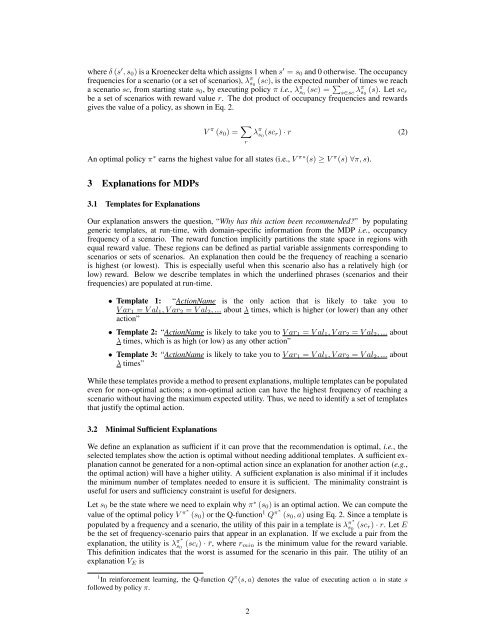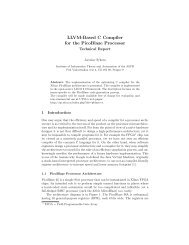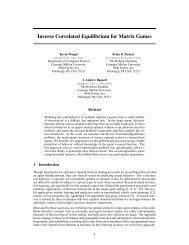decision making with multiple imperfect decision makers - Institute of ...
decision making with multiple imperfect decision makers - Institute of ...
decision making with multiple imperfect decision makers - Institute of ...
Create successful ePaper yourself
Turn your PDF publications into a flip-book with our unique Google optimized e-Paper software.
where δ (s ′ , s 0 ) is a Kroenecker delta which assigns 1 when s ′ = s 0 and 0 otherwise. The occupancyfrequencies for a scenario (or a set <strong>of</strong> scenarios), λ π s 0(sc), is the expected number <strong>of</strong> times we reacha scenario sc, from starting state s 0 , by executing policy π i.e., λ π s 0(sc) = ∑ s∈sc λπ s 0(s). Let sc rbe a set <strong>of</strong> scenarios <strong>with</strong> reward value r. The dot product <strong>of</strong> occupancy frequencies and rewardsgives the value <strong>of</strong> a policy, as shown in Eq. 2.V π (s 0 ) = ∑ rλ π s 0(sc r ) · r (2)An optimal policy π ∗ earns the highest value for all states (i.e., V π∗ (s) ≥ V π (s) ∀π, s).3 Explanations for MDPs3.1 Templates for ExplanationsOur explanation answers the question, “Why has this action been recommended?” by populatinggeneric templates, at run-time, <strong>with</strong> domain-specific information from the MDP i.e., occupancyfrequency <strong>of</strong> a scenario. The reward function implicitly partitions the state space in regions <strong>with</strong>equal reward value. These regions can be defined as partial variable assignments corresponding toscenarios or sets <strong>of</strong> scenarios. An explanation then could be the frequency <strong>of</strong> reaching a scenariois highest (or lowest). This is especially useful when this scenario also has a relatively high (orlow) reward. Below we describe templates in which the underlined phrases (scenarios and theirfrequencies) are populated at run-time.• Template 1: “ActionName is the only action that is likely to take you toV ar 1 = V al 1 , V ar 2 = V al 2 , ... about λ times, which is higher (or lower) than any otheraction”• Template 2: “ActionName is likely to take you to V ar 1 = V al 1 , V ar 2 = V al 2 , ... aboutλ times, which is as high (or low) as any other action”• Template 3: “ActionName is likely to take you to V ar 1 = V al 1 , V ar 2 = V al 2 , ... aboutλ times”While these templates provide a method to present explanations, <strong>multiple</strong> templates can be populatedeven for non-optimal actions; a non-optimal action can have the highest frequency <strong>of</strong> reaching ascenario <strong>with</strong>out having the maximum expected utility. Thus, we need to identify a set <strong>of</strong> templatesthat justify the optimal action.3.2 Minimal Sufficient ExplanationsWe define an explanation as sufficient if it can prove that the recommendation is optimal, i.e., theselected templates show the action is optimal <strong>with</strong>out needing additional templates. A sufficient explanationcannot be generated for a non-optimal action since an explanation for another action (e.g.,the optimal action) will have a higher utility. A sufficient explanation is also minimal if it includesthe minimum number <strong>of</strong> templates needed to ensure it is sufficient. The minimality constraint isuseful for users and sufficiency constraint is useful for designers.Let s 0 be the state where we need to explain why π ∗ (s 0 ) is an optimal action. We can compute thevalue <strong>of</strong> the optimal policy V π∗ (s 0 ) or the Q-function 1 Q π∗ (s 0 , a) using Eq. 2. Since a template ispopulated by a frequency and a scenario, the utility <strong>of</strong> this pair in a template is λ π∗s 0(sc r ) · r. Let Ebe the set <strong>of</strong> frequency-scenario pairs that appear in an explanation. If we exclude a pair from theexplanation, the utility is λ π∗s 0(sc i ) · ¯r, where r min is the minimum value for the reward variable.This definition indicates that the worst is assumed for the scenario in this pair. The utility <strong>of</strong> anexplanation V E is1 In reinforcement learning, the Q-function Q π (s, a) denotes the value <strong>of</strong> executing action a in state sfollowed by policy π.2







